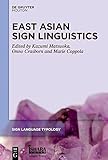East Asian Sign Linguistics / ed. by Kazumi Matsuoka, Onno Crasborn, Marie Coppola.
Material type: TextSeries: Sign Language Typology [SLT] ; 10Publisher: Berlin ; Boston : De Gruyter Mouton, [2022]Copyright date: ©2023Description: 1 online resource (VI, 349 p.)Content type:
TextSeries: Sign Language Typology [SLT] ; 10Publisher: Berlin ; Boston : De Gruyter Mouton, [2022]Copyright date: ©2023Description: 1 online resource (VI, 349 p.)Content type: - 9781501516986
- 9781501510168
- 9781501510243
- 419 23
- HV2474 .M38 2023
- online - DeGruyter
- Issued also in print.
| Item type | Current library | Call number | URL | Status | Notes | Barcode | |
|---|---|---|---|---|---|---|---|
 eBook
eBook
|
Biblioteca "Angelicum" Pont. Univ. S.Tommaso d'Aquino Nuvola online | online - DeGruyter (Browse shelf(Opens below)) | Online access | Not for loan (Accesso limitato) | Accesso per gli utenti autorizzati / Access for authorized users | (dgr)9781501510243 |
Frontmatter -- Contents -- Introduction -- Part 1: Manuals: Numerals, classifiers, modal verbs -- Historical relationships between numeral signs in Japanese Sign Language, South Korean Sign Language and Taiwan Sign Language -- Phonological processes in complex word formation in Shanghai Sign Language -- Classifiers and gender in Korean Sign Language -- Causative alternation in Tianjin Sign Language -- Epistemic modal verbs and negation in Japanese Sign Language -- Part 2: Non-manuals and space -- The Korean Sign Language (KSL) corpus and its first application on a study about mouth actions -- Negative polar questions in Hong Kong Sign Language -- Analyzing head nod expressions by L2 learners of Japanese Sign Language: A comparison with native Japanese Sign Language signers -- Composite utterances in Taiwan Sign Language -- Time and timelines in Tibetan Sign Language (TSL) interactions in Lhasa -- Index
restricted access online access with authorization star
http://purl.org/coar/access_right/c_16ec
This book is one of the first references of linguistic research of sign languages in East Asia (including China, Korea, Japan, Taiwan, and Hong Kong). The book includes the basic descriptions of aspects of Chinese (Shanghai, Tianjin) sign language, Hong Kong Sign Language, Japanese Sign Language, Korean Sign Language, Taiwanese Sign Language, and Tibetan Sign Language. Table of contents Introduction Kazumi Matsuoka, Onno Crasborn and Marie Coppola Part 1: Manuals: Numerals, classifiers, modal verbs Historical relationships between numeral signs in Japanese Sign Language, South Korean Sign Language and Taiwan Sign Language Keiko Sagara Phonological processes in complex word formation in Shanghai Sign Language Shengyun Gu Classifiers and gender in Korean Sign Language Ki-Hyun Nam and Kang-Suk Byu Causative alternation in Tianjin Sign Language Jia He and Gladys Tan Epistemic modal verbs and negation in Japanese Sign Language Kazumi Matsuoka, Uiko Yano and Kazumi Maegawa Part 2: Non-manuals and space The Korean Sign Language (KSL) corpus and its first application on a study about mouth actions Sung-Eun Hong, Seong Ok Won, Hyunhwa Lee, Kang-Suk Byun and Eun-Young Lee Negative polar questions in Hong Kong Sign Language Felix Sze and Helen Le Analyzing head nod expressions by L2 learners of Japanese Sign Language: A comparison with native Japanese Sign Language signers Natsuko Shimotani Composite utterances in Taiwan Sign Language Shiou-fen Su Time and timelines in Tibetan Sign Language (TSL) interactions in Lhasa Theresia Hofer
Issued also in print.
Mode of access: Internet via World Wide Web.
In English.
Description based on online resource; title from PDF title page (publisher's Web site, viewed 25. Jun 2024)


